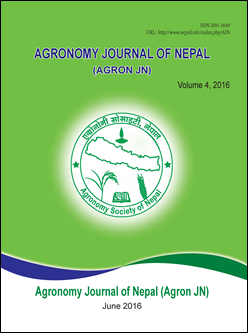Commercial Vegetable Farming: An Approach for Poverty Reduction in Nepal
DOI:
https://doi.org/10.3126/ajn.v4i0.15518Keywords:
PRISM approach, Vegetable subsector, Subsistence farming, Commercialization, Marketing channelAbstract
Poverty reduction of farmers from Kapilbastu and Kaski districts were evaluated with respect to the vegetable farming where PRISM (Prosperity Realization through Irrigation and Smallholder Markets) technology was implemented. After the implementation of PRISM there has been considerable increase in vegetable farming area in both districts. Numbers of vegetable crops grown were increased with respect to yield and net return from both the winter and summer vegetables. With the opening of organized markets and large scale increase in income, farmers were attracted towards vegetable cultivation that provided wide range of vegetables for consumers as well. Earlier farmers cultivated vegetables only when there would be fallow land after the harvest of main season cereal crops while after the adoption of new technology farmers grew vegetables all the yearround. Among the popular vegetables during summer was cucumber in the hills and okra in the Terai covering more land than other vegetables crops in the study area. These cropshelp farmers achieve net return of NRs.25240.6 and from NRs. 20425.4 per Ropani in Kaski and Kapilbastu, respectively. Land area under vegetables crops were increased by 6 times in Kaski and 12 times in Kapilbastu. This increase in net return has been found as a result of creating better marketing system developed by the activity of the PRISM. Similarly, involvement of household in summer season vegetable was not enough and farmers hired labor for commercial vegetables cultivation.
Agronomy Journal of Nepal (Agron JN), Vol.4, 2016, page: 92-106
Downloads
Downloads
Published
How to Cite
Issue
Section
License
ASON permits for free use, distribution and reproduction in any medium if the original work is properly cited and not used for commercial purposes.




